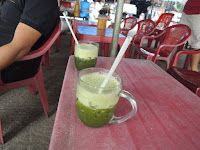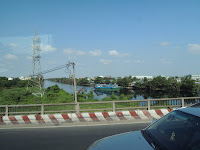The last organised tour for this holiday was a trip to the battlefields where the First Australian Task Force (1ATF) served in the Vietnam War. There are two reasons for making this trip:
As usual, a long drive to the tour region, this time in a large 4WD vehicle as I was on a tour on my own with a driver (Man) and a guide (Long). We drove out of Saigon through a (relatively) new tunnel under the Saigon River and through a new district that is being developed. We drove past the tallest building in Vietnam, an apartment building at 83m high, according to Long.
 |  |
| Vietnam's tallest building |
 |
| The Saigon River | New buildings in this new district |
We drove along a 'freeway' which was not especially busy but was limited to 80 km/h which meant that the 100+ km we had to travel took 90 minutes. During that time, Long regaled me with many stories of the Vietnam War (including several examples of how the North Vietnamese Army (NVA) would use propaganda during the war, underplaying the cost of various engagements) and then more of Vietnamese history, explaining how the French colonised Vietnam, how the country was divided by the transition to the communist party, and how the North Vietnamese were prosecuting a civil war against the South Vietnamese who reached out to their allies, the United States for support. That escalated, as history retells into the Vietnam War until the United States withdrew and the North Vietnamese overran the South Vietnamese.
Long also explained the difference between the NVA and the Viet Cong (correctly pronounced Viet Com - for communist). The Viet Com were farmers who took up (primitive) arms to protect their lands (at the encouragement of the NVA). They didn't wear uniforms and they were not officially armed by anyone, hence using knives and spears, etc.
Eventually, we got to Long Tan and had a short pause for a restroom break and a refreshing drink, which I think was made from blended pandanus leaves. We met another tour guide there, a North Vietnamese veteran. He was an interesting fellow and reminded me of the Aussie Vietnam veterans that I've met in his character and appearance.
 |  |
| Long Tan is a small town, typical of Vietnam, though with new, well-presented streets in it's the main district |
 |  |  |
| The water tower has been in Long Tan since the war |
Our first stop on the tour was at a memorial hall for the local Vietnamese veterans and to visit a tunnel that was part of a single long tunnel system here in the south. I hadn't realised that a tunnel visit was part of the deal and I had not been interested in being involved in the Chu Chi tunnels trip that the other Intrepid folks did the day before. However, it was a larger tunnel and not the site of hand-to-hand fighting in the dark (apparently).
 |  |
| The memorial hall | Weapons on display |
 |  |
| Statues protecting the memorial hall |
 |  |
| The tools used to dig the tunnel and fight the war | Domestic tools and implements used in the tunnel |
 |  |
| The tunnel (~ 190cm high, 40cm wide) | A lookout point from the tunnel |
From the tunnel site near the town of Long Tan, we drove out into the rubber tree plantations that were the site of the actual Battle of Long Tan. Long explained that rubber plantations take five years to grow to sufficient maturity to milk the trees and then they are productive for 25 to 30 years. Then they are cut down and a new plantation started. He briefed me on this to explain that where the battle took place was in a mature rubber plantation even though it is an immature plantation now.
There is very little to see here, perhaps unsurprisingly. The memorial is the site of the actual battle where 18 Australians lost their lives. (Apparently, the NVA lost ~340 men, though the NVA reports different casualty levels on both sides.) It is a sombre place and I laid flowers that had been bought for me by the guides on the memorial and lit a stick of incense too.
 |  |
| The walkway from the road to the memorial | The memorial at Long Tan |
 |  |
 |  |  |
| The immature plantation around the memorial | Views of a mature plantation, apparently what was there when the war took place |
We drove around to the hill in the shot above so that I could be shown what that observation point (used by both the Australians and the NVA/Viet Com, apparently) showed of the surrounding countryside.
 |  |
| The observation point - now a privately held quarry | The view back towards the memorial from the observation point |
We then drove around to the former Australian-run airfield at Nui Dat. The former runway is the main road to this tiny village and there is a (now abandoned) kindergarten/orphanage nearby that was funded by Australian Vietnam veterans.
 |  |
| The former runway of the airfield at Nui Dat |
 |  |
| The Australian-sponsored kindergarten/orphanage - clearly abandoned | Evidence that Nui Dat is not diminishing; a new, clearly wealthy household on the runway |
We drove a short distance out of Nui Dat to stop on the road and visit the ruins of the Australian base there. This is a site that has not been preserved at all and there are only ruins of the gate, a bunker/underground store and a memorial stone seemingly randomly distributed through the rubber plantation.
 |
| The bunker through the trees |
 |  |
| The bunker/store from an old Australian Base | A memorial stone in the Australian base (apparently, set there during the war and formerly painted with names of the fallen) |
 |  |
| The rubble of the former base gate |
The tour was over after that. We drove back to Saigon and my excellent guides dropped me at my hotel. I headed down the road to an interesting looking bar/restaurant I'd seen the other day for lunch and then spent the afternoon in my room, pfaffing around with my computer and watching movies on the TV.
 |  |
| The restaurant where I had lunch |












































































